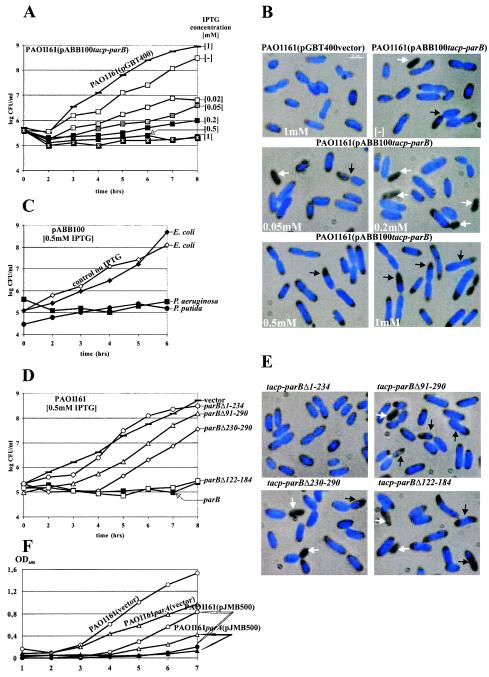FIG.5.
Inhibition of host growth by the expression of parB. Overnight bacterial cultures carrying the plasmids indicated and grown under selection were diluted 104-fold into fresh selective medium without or with IPTG over a range of concentrations. Every hour, culture samples were serially diluted, and 20-μl aliquots were spotted on L agar and L agar-streptomycin plates. No plasmid loss was observed. The data shown are based on CFU from L agar plates. After approximately 4 h, samples were stained with DAPI and studied. (A) Effect on the growth of PAO1161 of increasing ParB expression from pABB100. Bacteria with empty vector pGBT400 and grown with 1 mM IPTG were used as the negative control. (B) Fluorescent images of samples from cultures monitored in panel A. White arrows indicate anucleate cells; black arrows indicate dislocalized, condensed chromosomes. (C) Effect of ParB production on the growth of E. coli DH5α and P. putida KT2442 carrying pABB100. PAO1161(pABB100) was used as a control. The data for all cultures grown without IPTG looked very similar and are represented by DH5α(pABB100) as the control (no IPTG). (D) Effect of overproduction of truncated forms of ParB on P. aeruginosa growth. PAO1161(pGBT400) not producing ParB and PAO1161(pABB100) producing wild-type ParB were used as controls. No difference in growth was observed for uninduced cultures. Only data for the induced cultures are presented. Expression plasmids with different derivatives of parB are listed in Table 1. (E) Fluorescent images of PAO1161 transformants overproducing truncated forms of ParB. The cultures were sampled after 4 h of growth in the presence of 0.5 mM IPTG. White arrows indicate anucleate cells; black arrows indicate cells with condensed chromosomes. (F) Effect of ParB overproduction on the growth of the PAO1161 parA::smh strain. The broad-host-range plasmid pBBR1MCS1 and its derivative pJMB500 carrying lacIq and a tacp- parB transcriptional fusion were used to transform PAO1161 parA and PAO1161. The cultures of the transformants were diluted 100-fold into L broth with 0.5 mM IPTG and without IPTG. Growth was monitored as the OD600. The growth of strains with vector pBBR1MCS1 is shown only for cultures with 0.5 mM IPTG.

